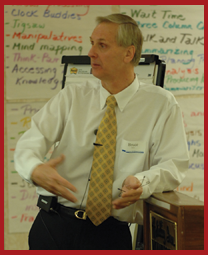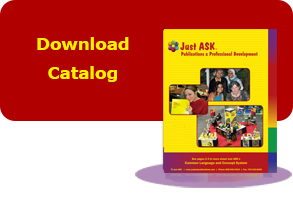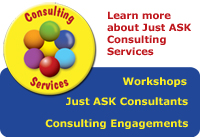
Volume III Issue V
Share this newsletter on
Rethinking Assessment Practices

Bruce facilitating a Leading the Learning® workshop
No topic has captured my attention more than assessment and the way educators go about assessing student learning. A defining moment for me was when I read an article by University of Kentucky professor Thomas Guskey in which he questioned the practice of giving students only one opportunity to show what they had learned. After that first article, I read other articles and did more research on assessment practices. The more I read the more I questioned how we assess our students. Through my many conversations with educators, I have concluded that we simply assess the way we were assessed when we were students without stopping to think about why we do what we do, or whether it is the best way to determine if students are truly learning what we want them to learn.
In addition to Dr. Guskey’s work, my journey through the literature on assessment and the thinking of Douglas Reeves, Rick Stiggins, Grant Wiggins, Michael Fullan and others caused me to revise my thinking. In addition to questioning the practice of only allowing students one chance on an assessment, I’ve thought about other approaches which educators follow without thinking about the impact on students. Why do we average grades instead of concentrating on what students have learned? Why do we give partial credit when students take the time to make corrections and resubmit their work? Why do we create assessments that require students to “guess what’s on the teacher’s mind?” And why do we continue to do the same thing again and again when it is clear that students are not successful and learning is not occurring?
As I reflected on assessment over the past months, I reached a number of conclusions. Below are my Top Ten Suggestions for Rethinking Assessment Practices.
Emphasize learning, not grading. Some educators lose sight of student learning as their ultimate goal. Some become so wrapped up in grading practices that the focus on our primary responsibility, student learning, is lost. Recently I encountered a student who received a “D” on his report card when he had earned a “B” on the summative unit assessment. In the teacher’s list of “grades,” he had missed two homeworks, one journal entry and received an “F” on a pop quiz. The teacher’s grading practice allotted a certain percentage to each portion of the items in the grade book. In short, she followed the practice of averaging grades instead of focusing on what the student ultimately learned. Averaging grades is often in conflict with student learning and yet we accept the practice without questioning why we do it.
Give students multiple opportunities to show what they have learned. Assessments should not be a one-shot, do-or-die undertaking for students. We should apply the same common sense to assessing student learning as we do to teaching a loved one or colleague something new. When we teach a teenager to drive, we don’t just continue to tell him he’s failing or give him a “bad grade.” We give continuous feedback and allow him to try and try again until he learns. If we teach a colleague a new technology application, we sit with them and answer their questions until we see that they can use the skill independently. As learners ourselves, nothing is more frustrating than having a knowledgeable individual present us with information and then leave us floundering as we struggle to figure out new learning on our own. We should use the learning principles with our students that we want for ourselves when we are undertaking new learning. A fellow principal established the practice in her school which she called “A, B, C or Do It Over.” Students were expected to work until they had earned a minimum of a grade of “C.” The emphasis was on teaching students to persevere until they had achieved a goal.
Eliminate zeros. There is no practice in education that discourages students more than the practice of giving a zero for an incomplete assignment or an assignment that is not turned in. When a teacher gives a zero, it is the expectation that the grade will be a “wake up call” for the student who will then be motivated to improve his or her performance. The practice often has the exact opposite effect. Typically a student will shut down and stop working because he or she knows that it is impossible to rebound from that zero. I have also heard of situations where teachers follow the unfortunate practice of assigning zeros as a punishment to students which is a misuse of a teacher’s authority. I am not sure where the idea of zeros came from but it is a practice that is counter to our goal of motivating students to learn and to have students be active participants in the educational process. One principal, who felt that the practice was unfair to students, conducted a faculty meeting session in which staff members discussed alternatives to assigning zeros. The principal collected that data from the discussions and more productive alternatives were shared with the entire staff.
Be up front with students about how learning will be assessed. It is critical that assessments be aligned with the standards that are taught. The guideline for teachers should be to “take the mystery out of mastery.” As Paula Rutherford writes, educators should follow The Three Ps in relation to assessment: Prior to giving an assessment to students, the teacher should be public about how students will be assessed as well as telling the students precisely how learning will be measured. All of us are better able to work toward achieving a goal when we know what the goal is.
Build student confidence. The research on learning is perfectly clear. When teachers use assessments accurately and appropriately, student success follows. When students experience success on a regular basis, they develop confidence and build optimism. They develop a strong desire to succeed, learn to analyze their mistakes, put forth a high level of effort and take risks as they stretch themselves as learners. On the other hand, repeated failure results in pessimism, a sense of hopelessness, decreasing effort, and expectations that assessment results will be negative. Teachers have the power to build student confidence through the way that they plan lessons, and that is the kind of power a teacher should always exert. By completing an analysis of the assignments that a teacher expects students to complete, and by differentiating instruction to ensure that all students can accomplish the work that is being assigned, a teacher can do a great deal to instill an “I can do it” attitude in every student.
Offer choice. When students have some ownership in their learning, they become more engaged and interested in participating in the learning experience. By allowing students some choice in how they learn (research topics, books for reading, projects, outlining, free writing, webbing, etc.) they become more intrinsically motivated. When a teacher allows students on occasion to choose how to demonstrate their learning, the essential understandings become more personal and long-lasting. See the template from Instruction for All Students by Paula Rutherford. This template provides students opportunities to not only select their assessment format but gives them responsibility for creating a plan of action and the assessment criteria. See pages 175-180 in Instruction for All Students for an extensive list of products students can create to demonstrate their learning.
Use formative assessment data properly. Formative data (while learning is being “formed”) can be misused by teachers. The results of formative assessments (pre-assessments, checks for understanding, student self-assessments, journal writing, quizzes) are often used to determine a student’s final grade for a marking period. Formative assessments provide information to both the teacher and the student as learning is taking place. Once students have had the chance to use teacher feedback and formative assessment data, a teacher can administer a summative assessment which allows students to show what they have ultimately learned.
Expand assessment repertoires. My belief as a principal was that we should do “whatever it takes” to promote and measure student learning. Educators should be lifelong learners who are constantly adding to their instructional approaches as well as ways to assess student learning. Principals must create opportunities for teachers to routinely collaborate with their peers and exchange assessment ideas and teachers must continuously seek out new strategies and approaches. In short, we should be searching for the keys to student success.
Think long range. Our ultimate goal as educators is to have our students learn to self-assess by reflecting on their own efforts and learning and then self-adjust. We want our students to think of assessment and adjustment of behaviors and practices as not only as steps in the learning process but also as essential life skills. We can promote this mindset by carefully structuring the learning environment for students.
Remember the person behind the numbers. Despite the large number of students we work with each day, we must always remember that a student cannot be reduced to a number or a grade. The more personal interest we take in each of our students, the greater the likelihood that the student will become more involved in the learning. As human beings, we all want to experience success. We have feelings and aspirations. Our students are no different. When frustrated, they often resort to acting defensively or seemingly uninterested. When we focus on the person behind the numbers in our grade book, we may discover that ingredient that will turn each student onto learning.
For many students, school is a frustrating experience. They become quickly discouraged when they are unsuccessful. By rethinking some of the accepted practices that we “inherit” in education, and by implementing alternative approaches that stress true learning, we can make our classrooms better places for our students, places where a high level of energy abounds because students want to be there.
Permission is granted for reprinting and distribution of this newsletter for non-commercial use only. Please include the following citation on all copies:
Oliver, Bruce. “Rethinking Assessment Practices.” Just for the ASKing! April 2006. Reproduced with permission of Just ASK Publications & Professional Development (Just ASK). © 2006 Just ASK. All rights reserved. Available at www.justaskpublications.com.



